Thermal Effects of Electromagnetic Energy on Skin in Contact with Metal: A Numerical Analysis
Abstract
:1. Introduction
2. Formulation of the Problem
3. Methods and Model
3.1. Physical Model
3.2. Equations for Electromagnetic Field Analysis
- The electromagnetic field was modeled in a 2D axisymmetric geometry.
- The electromagnetic field was interacting with the metal and tissue in the open space.
- The free space was truncated by an infinite element domain.
- The model assumes that the dielectric properties of metal and tissue are constant.
3.3. Equations for Heat Transfer Analysis
- The heat transport was represented by a 2D axisymmetric geometry.
- The tissue and metal had constant thermal properties.
- During the exposure, no material phases changed.
- There was no chemical response in the tissue.
- The tissue was homogeneous and thermally isotropic.
3.4. Calculation Procedure
4. Results and Discussion
4.1. Verification of the Model
4.2. Effect of Plate Material
4.3. Effect of Plate Thickness
4.4. Effect of Coil Distance
4.5. Effect of Exposure Time
5. Conclusions
Author Contributions
Funding
Data Availability Statement
Acknowledgments
Conflicts of Interest
References
- Guido, K.; Kiourti, A. Wireless wearables and implants: A dosimetry review. Bioelectromagnetics 2020, 41, 3–20. [Google Scholar] [CrossRef] [Green Version]
- Ju, Y.S. Thermal management and control of wearable devices. iScience 2022, 25, 104587. [Google Scholar] [CrossRef] [PubMed]
- Johnson, N.N.; Abraham, J.P.; Helgeson, Z.I.; Minkowycz, W.J.; Sparrow, E. An archive of skin-layer thicknesses and properties and calculations of scald burns with comparisons to experimental observations. J. Therm. Sci. Eng. Appl. 2011, 3, 011003. [Google Scholar] [CrossRef]
- IEC 60601-2-33; Particular Requirements for the Safety of Magnetic Resonance Equipment. IEC: Geneva, Switzerland, 2010.
- Fu, M.; Weng, W.G.; Yuan, H.Y. Numerical simulation of the effects of blood perfusion, water diffusion, and vaporization on the skin temperature and burn injuries. Numer. Heat Transf. Part A Appl. 2014, 65, 1187–1203. [Google Scholar] [CrossRef]
- Monds, J.R.; McDonald, A.G. Determination of skin temperature distribution and heat flux during simulated fires using Green’s functions over finite-length scales. Appl. Therm. Eng. 2013, 50, 593–603. [Google Scholar] [CrossRef]
- Yang, J.; Su, Y.; Song, G.; Li, R.; Xiang, C. A new approach to predict heat stress and skin burn of firefighter under low-level thermal radiation. Int. J. Therm. Sci. 2019, 145, 106021. [Google Scholar] [CrossRef]
- Abraham, J.P.; Hennessey, M.P.; Minkowycz, W.J. A simple algebraic model to predict burn depth and injury. Int. Commun. Heat Mass Transf. 2011, 38, 1169–1171. [Google Scholar] [CrossRef]
- Log, T. Analysis of Expected Skin Burns from Accepted Process Flare Heat Radiation Levels to Public Passersby. Energies 2021, 14, 5474. [Google Scholar] [CrossRef]
- Subramanian, B.; Chato, J.C. Safe touch temperatures for hot plates. J. Biomech. Eng. 1998, 120, 727–736. [Google Scholar] [CrossRef]
- Ng, E.Y.K.; Tan, H.M.; Ooi, E.H. Prediction and parametric analysis of thermal profiles within heated human skin using the boundary element method. Philos. Transact. A Math. Phys. Eng. Sci. 2010, 368, 655–678. [Google Scholar] [CrossRef]
- Abraham, J.P.; Stark, J.; Gorman, J.; Sparrow, E.; Minkowycz, W.J. Tissue burns due to contact between a skin surface and highly conducting metallic media in the presence of inter-tissue boiling. Burns 2019, 45, 369–378. [Google Scholar] [CrossRef]
- Virtanen, H.; Huttunen, J.; Toropainen, A.; Lappalainen, R. Interaction of mobile phones with superficial passive metallic implants. Phys. Med. Biol. 2005, 50, 2689–2700. [Google Scholar] [CrossRef] [PubMed]
- Virtanen, H.; Keshvari, J.; Lappalainen, R. The effect of authentic metallic implants on the SAR distribution of the head exposed to 900, 1800 and 2450 MHz dipole near field. Phys. Med. Biol. 2007, 52, 1221–1236. [Google Scholar] [CrossRef]
- Whittow, W.G.; Edwards, R.M. A study of changes to specific absorption rates in the human eye close to perfectly conducting spectacles within the radio frequency range 1.5 to 3.0 GHz. IEEE Trans. Antenn. Propag. 2004, 52, 3207–3212. [Google Scholar] [CrossRef]
- Whittow, W.G.; Panagamuwa, C.J.; Edwards, R.M. The energy absorbed in the human head due to ring-type jewelry and face-illuminating mobile phones using a dipole and a realistic source. IEEE Trans. Antenn. Propag. 2008, 56, 3812–3817. [Google Scholar] [CrossRef]
- Whittow, W.G.; Panagamuwa, C.J.; Edwards, R.M.; Vardaxoglou, J.C. On the effects of straight metallic jewellery on the specific absorption rates resulting from face-illuminating radio communication devices at popular cellular frequencies. Phys. Med. Biol. 2008, 53, 1167–1182. [Google Scholar] [CrossRef] [PubMed]
- Mat, M.H.; Malek, M.F.A.; Whittow, W.G.; Bibb, R. Ear prosthesis evaluation: Specific absorption rate levels in the head due to different angles and frequencies of electromagnetic exposure. J. Electromagn. Waves Appl. 2015, 29, 514–524. [Google Scholar]
- Wessapan, T.; Rattanadecho, R. Temperature induced in human organs due to near-field and far-field electromagnetic exposure effects. Int. J. Heat Mass Transf. 2018, 119, 65–76. [Google Scholar] [CrossRef]
- Wessapan, T.; Rattanadecho, R. Temperature induced in the testicular and related tissues due to electromagnetic fields exposure at 900 MHz and 1800 MHz. Int. J. Heat Mass Transf. 2016, 102, 1130–1140. [Google Scholar] [CrossRef]
- Bhargava, D.; Leeprechanon, N.; Rattanadecho, R.; Wessapan, T. Specific absorption rate and temperature elevation in the human head due to overexposure to mobile phone radiation with different usage patterns. Int. J. Heat Mass Transf. 2019, 130, 1178–1188. [Google Scholar] [CrossRef]
- Bhargava, D.; Rattanadecho, R.; Wessapan, T. The effect of metal objects on the SAR and temperature increase in the human head exposed to dipole antenna (numerical analysis). Case Stud. Therm. Eng. 2020, 22, 100789. [Google Scholar] [CrossRef]
- Wessapan, T.; Rattanadecho, R. Effect of the body position on natural convection within the anterior chamber of the human eye during exposure to electromagnetic fields. Numer. Heat Transf. Part A Appl. 2016, 69, 1014–1028. [Google Scholar] [CrossRef]
- Wessapan, T.; Rattanadecho, R. Heat transfer analysis of the human eye during exposure to sauna therapy. Numer. Heat Transf. Part A Appl. 2015, 68, 566–582. [Google Scholar] [CrossRef]
- Wessapan, T.; Rattanadecho, R. Flow and heat transfer in biological tissue due to electromagnetic near-field exposure effects. Int. J. Heat Mass Transf. 2016, 97, 174–184. [Google Scholar] [CrossRef]
- Wongchadakul, P.; Rattanadecho, R.; Wessapan, T. Implementation of a thermomechanical model to simulate laser heating in shrinkage tissue (effects of wavelength, laser irradiation intensity, and irradiation beam area). Int. J. Therm. Sci. 2018, 134, 321–336. [Google Scholar] [CrossRef]
- Wessapan, T.; Rattanadecho, R. Acoustic streaming effect on flow and heat transfer in porous tissue during exposure to focused ultrasound. Case Stud. Therm. Eng. 2020, 21, 100670. [Google Scholar] [CrossRef]
- Pennes, H.H. Analysis of tissue and arterial blood temperatures in the resting human forearm. J. Appl. Physiol. 1948, 1, 93–122, Erratum in J. Appl. Physiol. 1998, 85, 5–34. [Google Scholar] [CrossRef]
- Tucci, C.; Trujillo, M.; Berjano, E.; Iasiello, M.; Andreozzi, A.; Vanoli, G.P. Mathematical modeling of microwave liver ablation with a variable-porosity medium approach. Comput. Methods Programs Biomed. 2022, 214, 106569. [Google Scholar] [CrossRef]
- Adabbo, G.; Andreozzi, A.; Iasiello, M.; Netti, P.A.; Vanoli, G.P. A 3D numerical model of controlled drug delivery to solid tumor by means of mild microwave hyperthermia-activated thermo-sensitive liposomes. Int. J. Therm. Sci. 2023, 193, 108528. [Google Scholar] [CrossRef]
- Singh, S.; Melnik, R. Domain heterogeneity in radiofrequency therapies for pain relief: A computational study with coupled models. Bioengineering 2020, 7, 35. [Google Scholar] [CrossRef] [Green Version]
- Cano-Pleite, E.; Fernández-Torrijos, M.; Santana, D.; Acosta-Iborra, A. Heat generation depth and temperature distribution in solar receiver tubes subjected to induction. Appl. Therm. Eng. 2022, 204, 117902. [Google Scholar] [CrossRef]

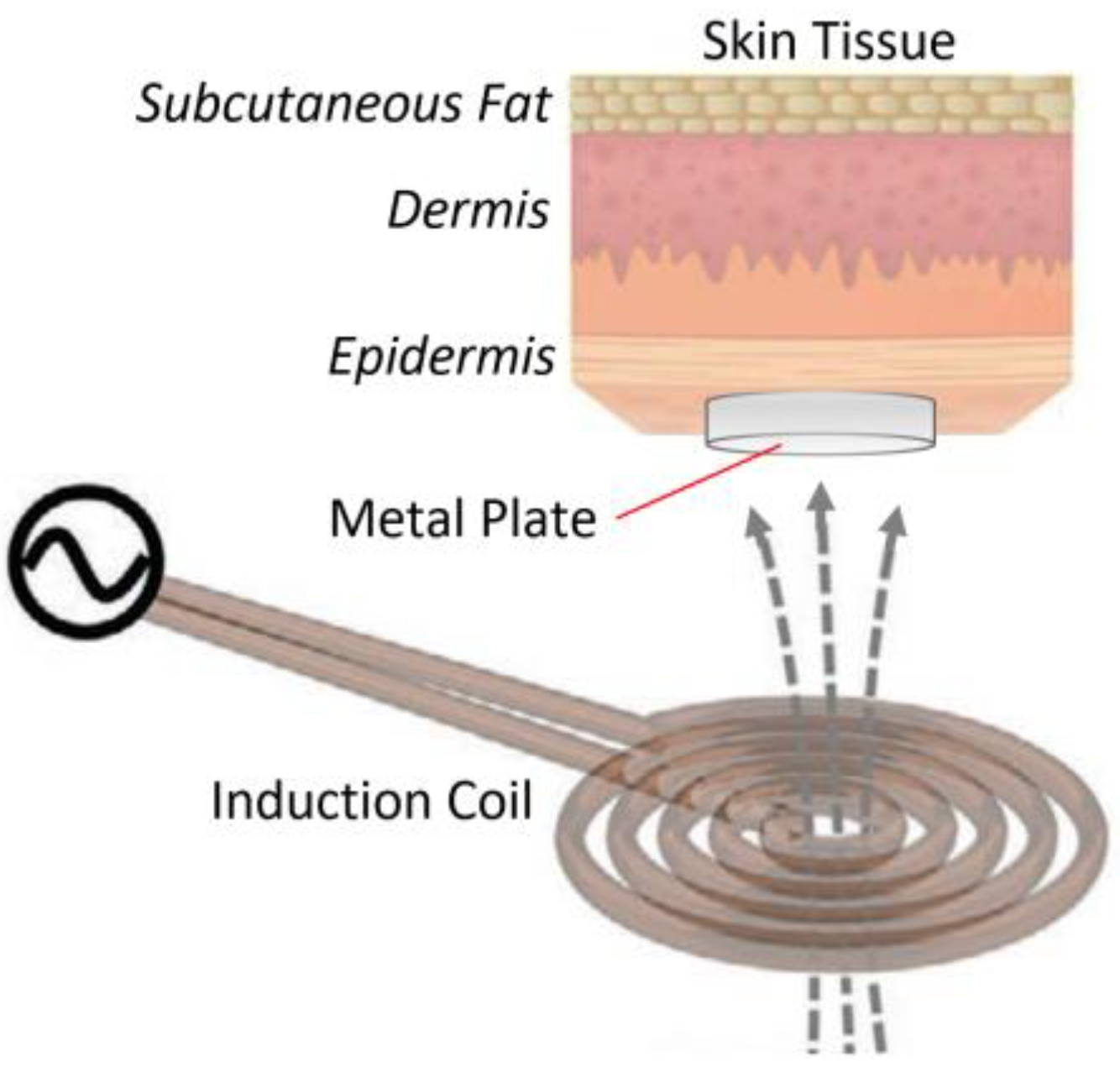
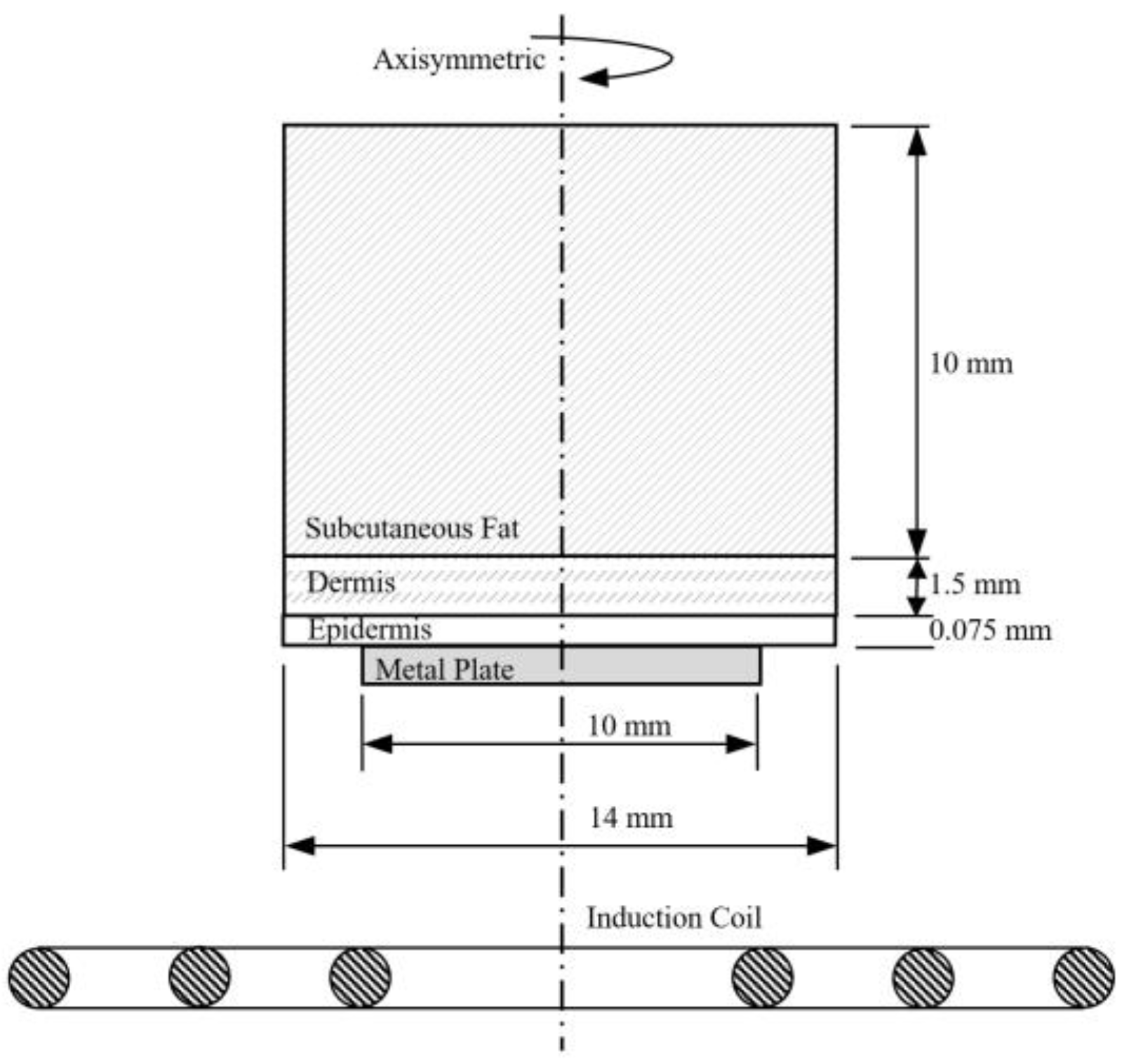
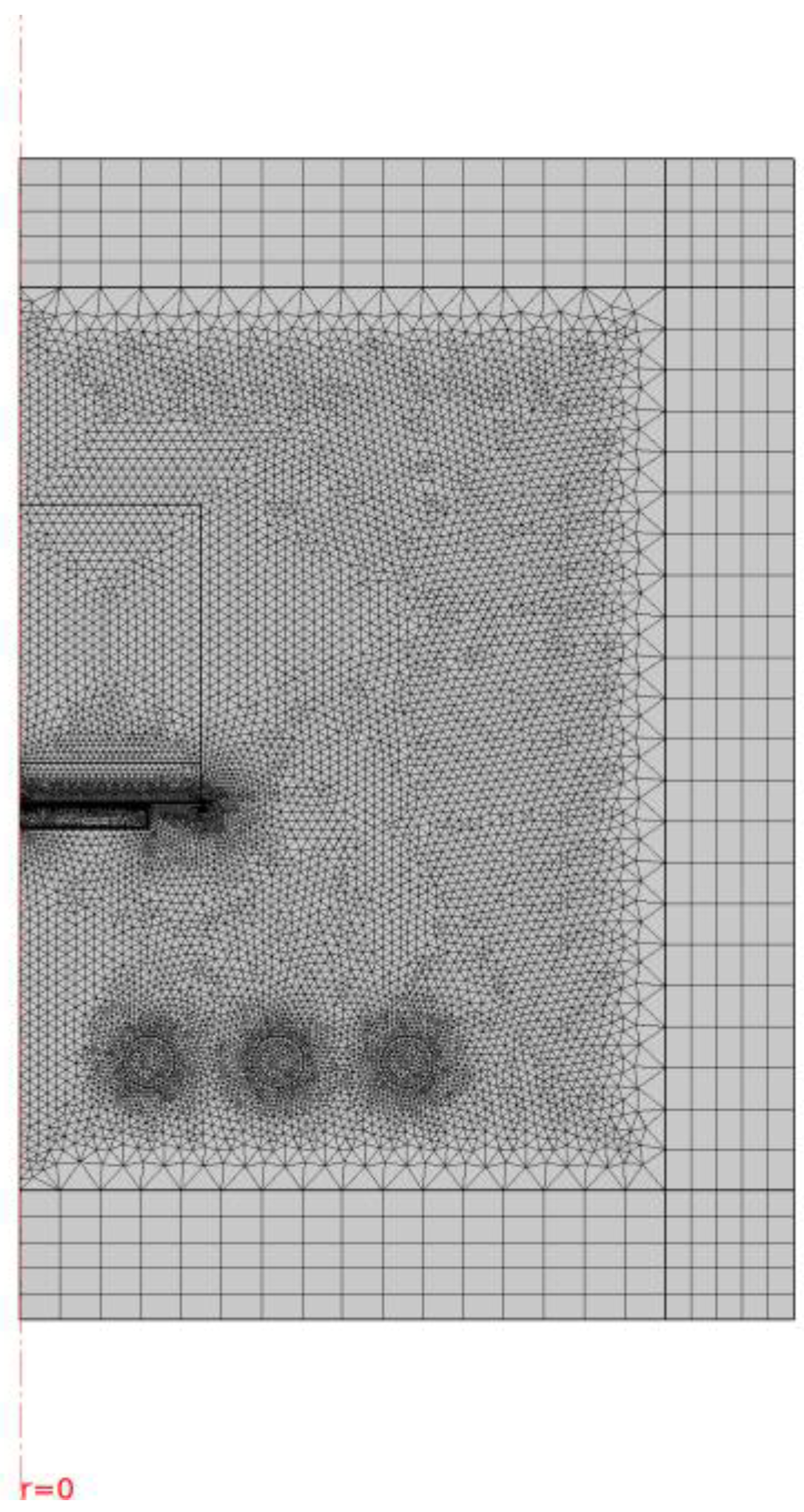
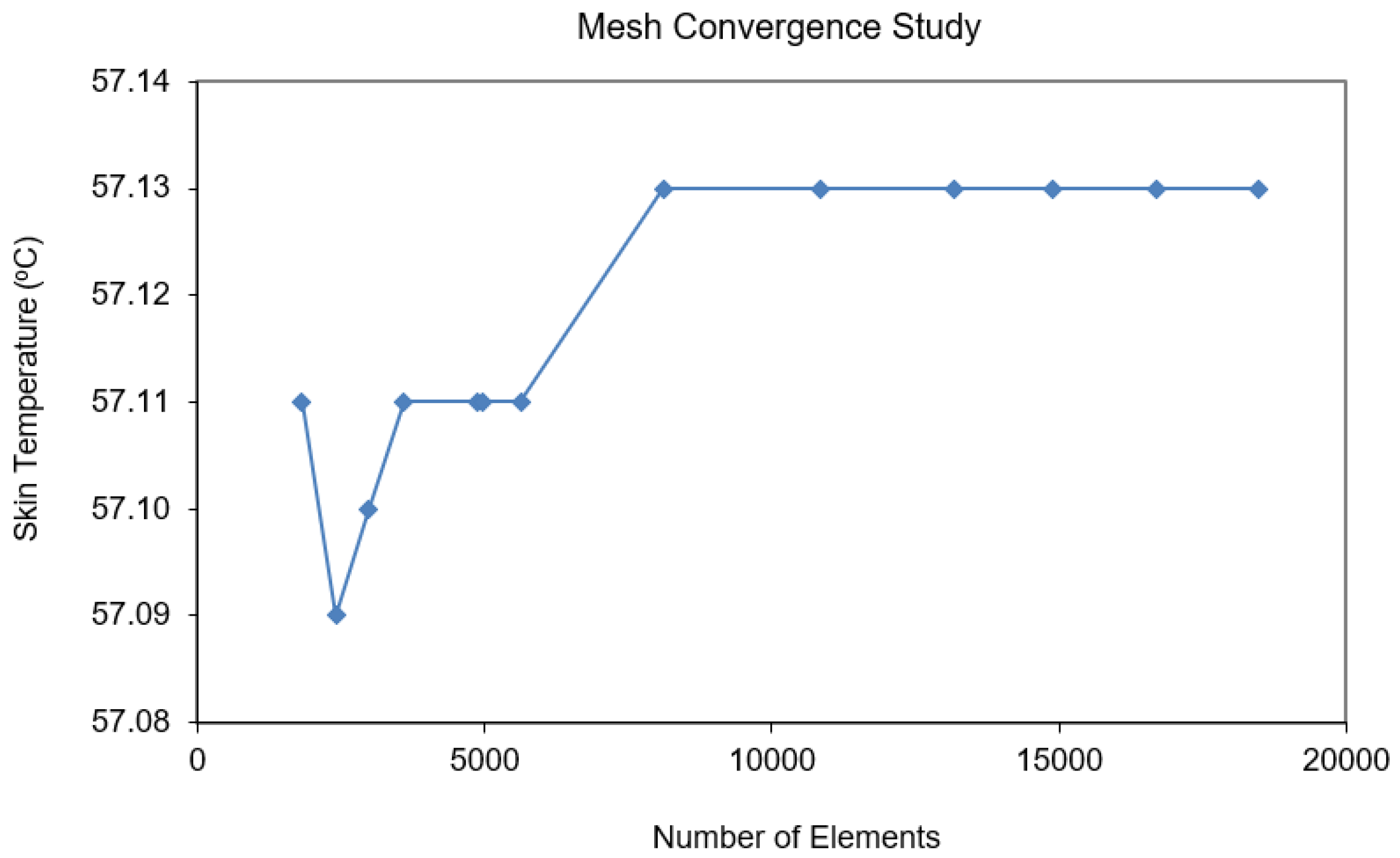



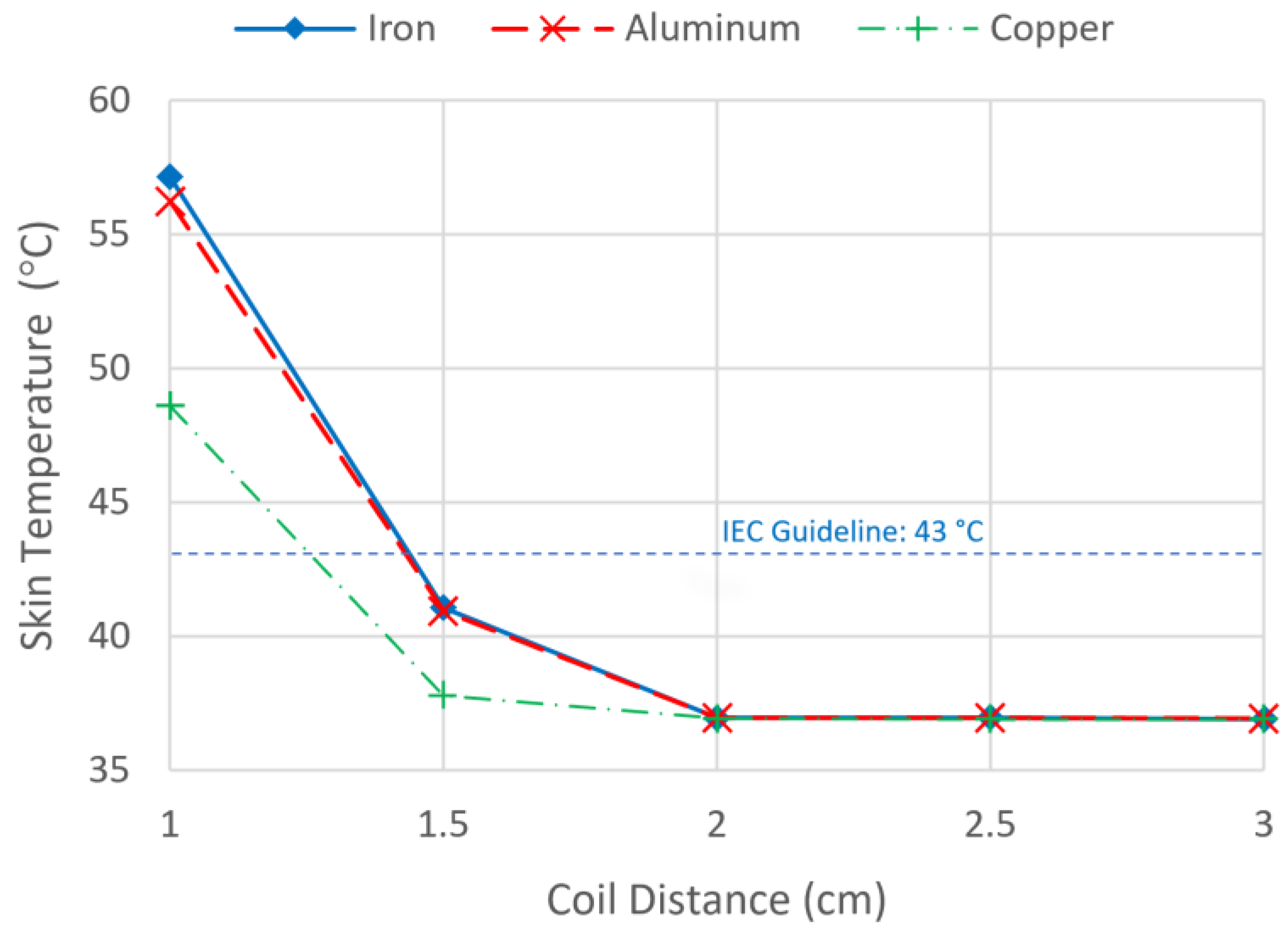
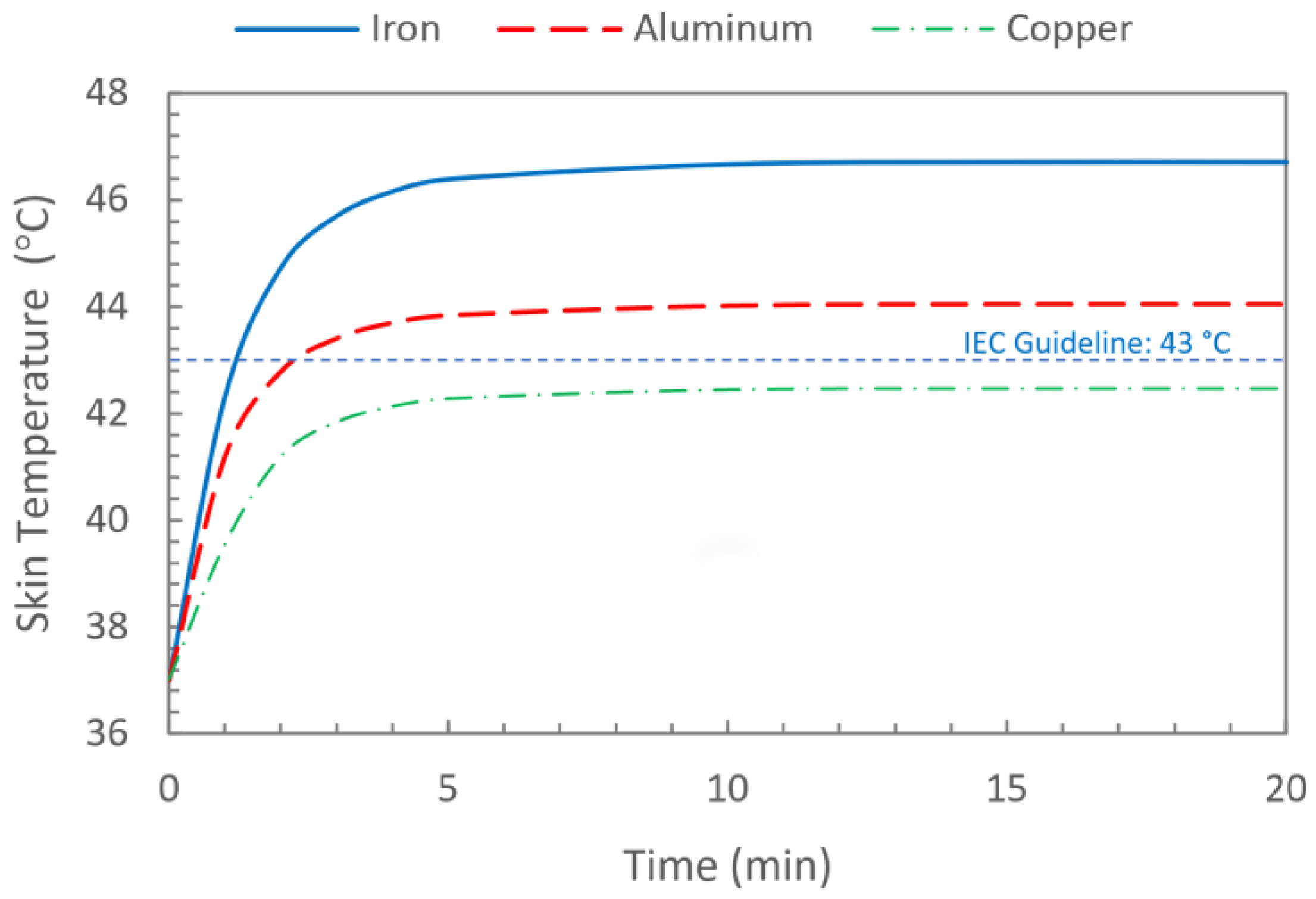
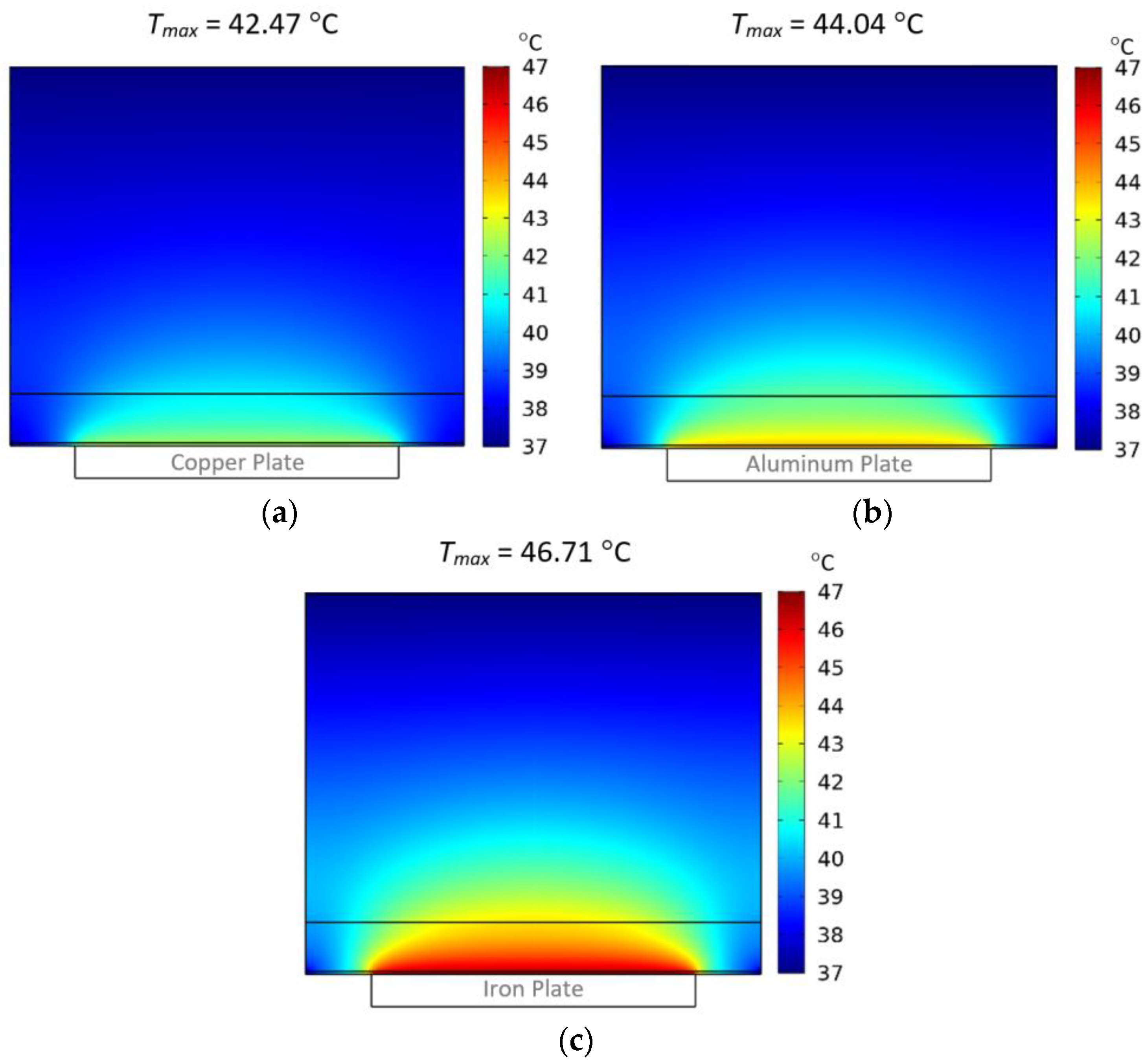
| Material | Density (ρ) (kg/m3) | Thermal Conductivity (k) (W/m·K) | Heat Capacity (C) (J/kg·°C) | Blood Perfusion Rate (ωb) (1/s) | Electrical Conductivity (σ) (S/m) | Relative Permittivity (εr) | Relative Permeability (μr) |
|---|---|---|---|---|---|---|---|
| Epidermis | 1200 | 0.21 | 3600 | 0.024 | 1.18 | 38.9 | 1 |
| Dermis | 1200 | 0.37 | 3600 | 0.024 | 1.18 | 38.9 | 1 |
| Subcutaneous fat | 900 | 0.16 | 2500 | 0.00058 | 0.19 | 11.0 | 1 |
| Iron | 7870 | 71.97 | 448 | - | 1.17 × 107 | 1 | 300 |
| Aluminum | 2698 | 225.94 | 921 | - | 3.5 × 107 | 1 | 1 |
| Copper | 8960 | 400 | 385 | - | 5.96 × 107 | 1 | 0.999994 |
| Air | 1.29 | 0.025 | 1004 | - | 0 | 1 | 1 |
Disclaimer/Publisher’s Note: The statements, opinions and data contained in all publications are solely those of the individual author(s) and contributor(s) and not of MDPI and/or the editor(s). MDPI and/or the editor(s) disclaim responsibility for any injury to people or property resulting from any ideas, methods, instructions or products referred to in the content. |
© 2023 by the authors. Licensee MDPI, Basel, Switzerland. This article is an open access article distributed under the terms and conditions of the Creative Commons Attribution (CC BY) license (https://creativecommons.org/licenses/by/4.0/).
Share and Cite
Wessapan, T.; Rattanadecho, P.; Somsuk, N.; Yamfang, M.; Guptasa, M.; Montienthong, P. Thermal Effects of Electromagnetic Energy on Skin in Contact with Metal: A Numerical Analysis. Energies 2023, 16, 5925. https://doi.org/10.3390/en16165925
Wessapan T, Rattanadecho P, Somsuk N, Yamfang M, Guptasa M, Montienthong P. Thermal Effects of Electromagnetic Energy on Skin in Contact with Metal: A Numerical Analysis. Energies. 2023; 16(16):5925. https://doi.org/10.3390/en16165925
Chicago/Turabian StyleWessapan, Teerapot, Phadungsak Rattanadecho, Nisakorn Somsuk, Manop Yamfang, Manaporn Guptasa, and Prempreeya Montienthong. 2023. "Thermal Effects of Electromagnetic Energy on Skin in Contact with Metal: A Numerical Analysis" Energies 16, no. 16: 5925. https://doi.org/10.3390/en16165925
APA StyleWessapan, T., Rattanadecho, P., Somsuk, N., Yamfang, M., Guptasa, M., & Montienthong, P. (2023). Thermal Effects of Electromagnetic Energy on Skin in Contact with Metal: A Numerical Analysis. Energies, 16(16), 5925. https://doi.org/10.3390/en16165925







